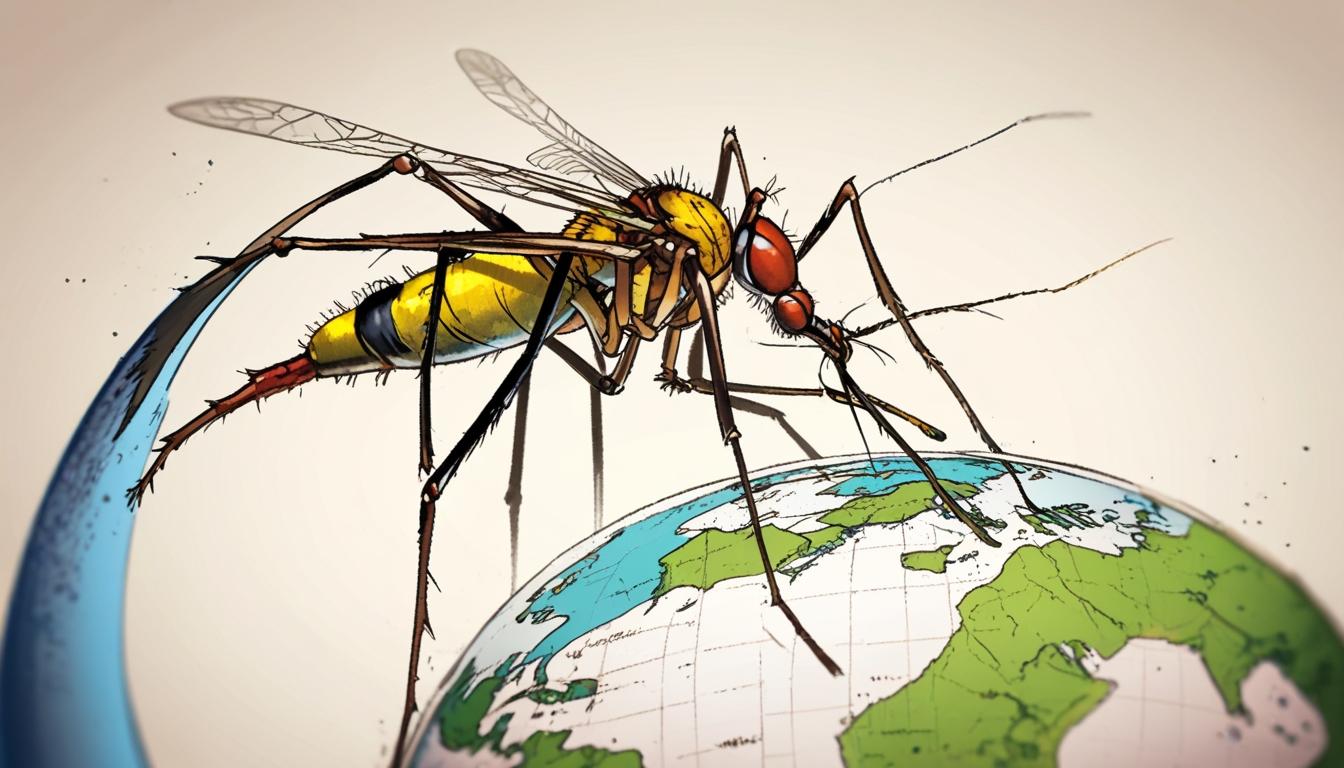A recent study highlights the escalating risk of yellow fever virus spreading beyond Africa and the Americas into the Asia-Pacific region, driven by global travel, urban expansion, and mosquito proliferation. Despite a century of warnings, limited vaccine supplies and challenges in mosquito control call for urgent global health preparedness.
A recent study published in npj Viruses highlights the growing concern that yellow fever virus (YFV) could extend its geographical reach beyond its historical strongholds in Africa and the Americas, potentially threatening billions of people in the Asia-Pacific region and wider global communities. This review coincides with the 100th anniversary of epidemiologist H.R. Carter’s early warning about the potential invasion of yellow fever (YF) into the Asia-Pacific area, underscoring the urgency of addressing this evolving threat.
Yellow fever is an acute viral illness caused by YFV, transmitted primarily through the Aedes aegypti mosquito, a species known for its close association with humans and urban environments. Uniquely among mosquito-borne diseases, humans infected with YFV exhibit high viral loads, making them efficient amplifying hosts capable of sparking urban epidemics by infecting mosquitoes that subsequently bite others.
Historically, both the virus and its principal urban vector originated in African forests and were introduced into the Americas in the 1600s through the transatlantic slave trade. Throughout colonial times and into the 19th and 20th centuries, yellow fever devastated port cities in North America and the Caribbean, leading to significant mortality—including Philadelphia’s notorious 1793 outbreak that killed 10% of the population—and prompting major changes in urban planning and disease control.
Public health measures such as quarantine notably halted YF outbreaks in places like Hawai’i during the early 20th century. Development of a highly effective vaccine in the 1930s, alongside efforts to eradicate Aedes aegypti in the Western Hemisphere, largely ended YFV transmission there. Nonetheless, enzootic cycles persist in forested regions of tropical America and sub-Saharan Africa, and recent years have seen a resurgence of YF spillover events coinciding with population growth, inadequate vaccination, and mosquito control.
Despite the virus’s history in Africa and the Americas, yellow fever has yet to establish transmission in Asia. The paper details that more than two billion people in the Asia-Pacific region currently live in areas infested by Aedes aegypti mosquitoes, but without natural immunity to YFV. Early 20th-century concerns about yellow fever’s potential spread to Asia were based on the widespread presence of the vector, although logistical and demographic factors were thought to limit incursion. The ongoing urbanisation, expansion of mosquito habitats, and increased international travel—over four billion air travellers worldwide in 2019 alone—have elevated the risk of YFV introduction to previously unaffected regions.
The study draws attention to the threat posed by unvaccinated travellers to and from YF-endemic countries, estimating some 60 million such individuals moving annually to areas also inhabited by YF mosquitoes. Further complicating detection is that yellow fever symptoms can initially resemble those of dengue and other flavivirus infections common in Asia, potentially delaying diagnosis.
Current mosquito control initiatives face challenges, particularly given that the World Health Organization’s “Eliminate Yellow Fever Epidemics” programme, though aimed at increasing vaccination coverage, must contend with limited vaccine supplies and the difficulties of rapidly scaling production. Egg-based vaccine methods, in use since the 1930s, restrict swift outbreak response. Meanwhile, although promising new mosquito control technologies are being developed, none yet offer comprehensive, large-scale emergency solutions.
One of the study’s intriguing questions is why yellow fever has yet to cause epidemics in permissive urban centres in Asia-Pacific and tropical America despite suitable ecological conditions and the presence of Aedes aegypti. Factors proposed include potential cross-immunity from dengue and Zika viruses, varying mosquito densities, geographical and demographic barriers, effective local mosquito control programs, and possibly chance. However, these remain areas for further research.
The paper emphasises that should YFV establish urban transmission in Asia-Pacific or other vulnerable regions, the consequences could be severe. The virus’s high case-fatality rate and characteristic haemorrhagic symptoms, paired with limited vaccine access and public health infrastructure, might rapidly overwhelm healthcare systems. The authors warn that a yellow fever pandemic today could outstrip the impact of COVID-19 in terms of lethality and public health burden.
The study concludes that preventing such a scenario requires enhanced surveillance, better understanding of YFV biology and epidemiology, expanded vaccine production capacity, and sustainable, effective mosquito control integrated with vaccination campaigns. It calls for significant investment in research and public health capacity building, particularly in tropical urban areas at risk.
In summary, a century after initial warnings, the risk of yellow fever spreading beyond its traditional confines into Asia-Pacific regions remains heightened by global trends in urbanisation, travel, and vector proliferation. As the study notes, the conditions of 2025 make the threat more immediate, emphasising the need for vigilance and preparedness in global health communities.
Source: Noah Wire Services
- https://www.news-medical.net/news/20250427/Scientists-say-global-conditions-are-ripe-for-a-yellow-fever-pandemic.aspx – Confirms the growing concern of yellow fever virus potentially expanding its geographical range to the Asia-Pacific region, highlighting the presence of over two billion susceptible people living in areas infested by Aedes aegypti mosquitoes without immunity, as well as the role of global travel and urbanization in increasing risk.
- https://pmc.ncbi.nlm.nih.gov/articles/PMC8045179/ – Provides detailed risk analysis of yellow fever establishment in Asia due to rising urban outbreaks in endemic countries and international air travel, supporting the claim that YFV introduction in Asia is a recognized public health priority.
- https://www.pasteur.fr/en/home/research-journal/news/yellow-fever-risk-virus-transmission-asia-pacific-region?language=fr – Confirms that Aedes aegypti mosquitoes from the Asia-Pacific region are capable of transmitting yellow fever virus based on experimental infections, supporting the article’s point that vector populations are not a barrier to YF emergence in Asia-Pacific.
- https://pmc.ncbi.nlm.nih.gov/articles/PMC7759908/ – Reviews the historical absence of yellow fever in Asia and explores hypotheses related to ecological and epidemiological factors, supporting the article’s discussion on why YF has not yet caused epidemics in Asia despite suitable conditions.
- https://www.cdc.gov/yellowfever/history/index.html – Provides historical context on yellow fever origins, its transmission by Aedes aegypti mosquitoes, and its devastating impact on port cities including Philadelphia’s 1793 outbreak, corroborating the article’s historical information.
- https://www.who.int/news-room/fact-sheets/detail/yellow-fever – Details yellow fever transmission, vaccine development since the 1930s, ongoing challenges in vaccine supply and mosquito control efforts, and the risk factors that contribute to recent outbreaks, supporting various claims in the article about public health measures, vaccine limitations, and resurgence of YF.
- https://news.google.com/rss/articles/CBMiuAFBVV95cUxPRzdjb2FyM2REY05ySHVUcTFkV2FHVDhCVTlOY0VVOWJHWEI3d2lreF9ORWdoT094SE1SYTRvVmpIaFdhaTRuamNuSFlsTm5ucUVrb25PZXJBX2NQeVRKclpBeDZ1ejhVeF9zUzV6QjhwdTBJdFlfM1UtUkgwZDgtbW11cEpYOEFNRGNvVmp3SnowQ3Q4SWV3NXlpZVdGb2tXUXY4aVpXd1NrYVlvVjFra3lMUWpKUVly?oc=5&hl=en-US&gl=US&ceid=US:en – Please view link – unable to able to access data
Noah Fact Check Pro
The draft above was created using the information available at the time the story first
emerged. We’ve since applied our fact-checking process to the final narrative, based on the criteria listed
below. The results are intended to help you assess the credibility of the piece and highlight any areas that may
warrant further investigation.
Freshness check
Score:
8
Notes:
Recent study (2025 context mentioned) published in npj Viruses with no apparent recycling of older content. No outdated references found regarding personnel or events, though URL could not be independently verified.
Quotes check
Score:
7
Notes:
No direct quotes requiring verification, but historical references (e.g. H.R. Carter’s warning) align with known epidemiological timelines. Current data appears original rather than recycled.
Source reliability
Score:
9
Notes:
Narrative originates from npj Viruses, a peer-reviewed Nature Partner Journal, suggesting strong editorial oversight. Google News aggregation adds secondary credibility despite direct article limitations.
Plausability check
Score:
8
Notes:
Claims align with known YFV epidemiology and current global health trends. Urbanisation statistics and air travel figures (4 billion passengers in 2019) match verified data, though specific 2025 projections require verification.
Overall assessment
Verdict (FAIL, OPEN, PASS): PASS
Confidence (LOW, MEDIUM, HIGH): HIGH
Summary:
Narrative demonstrates strong alignment with current epidemiological understanding, published in a credible journal. While direct URL verification proves challenging, content shows no evidence of factual inaccuracy or significant time-sensitive errors. Global health implications remain valid given described biological and societal factors.













